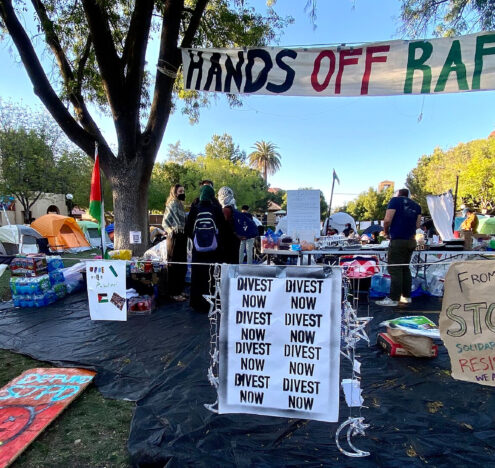[SPOILERS GALORE]
As much as I love my job as a Communications Associate at the Center for Arms Control and Non-Proliferation, there’s nothing more refreshing than taking a step back from the issues to pop on a film or a television show. However, art reflects the anxieties of the world around us, and as such I still find myself followed by nuclear weapons, whether it’s a throwaway comment or a major plot point.
In the wake of Oppenheimer, I decided to take a critical eye to films from around the world that found box-office success and contained nuclear weapons as a plot device. While Oppenheimer’s release has reminded us how films can draw more eyes to the nuclear field, we should be concerned about how blockbuster films from Hollywood to Bollywood subliminally encourage audiences to sit out of nuclear policy conversations.
Deus ex Machina
Tom Cruise seems to have an affinity for stopping nuclear disasters. At the climax of “Mission: Impossible – Fallout,” three nuclear bombs are primed to destroy the water supply of India, China and Pakistan. Superspy Ethan Hunt saves the day by wrestling a detonator from an impossibly handsome Henry Cavill, averting the nuclear poisoning plot. More recently, “Top Gun: Maverick” also had a nuclear dimension somewhat obscured by the razzle-dazzle of supersonic jets. The ticking clock that drives Maverick’s plot is an unsanctioned uranium enrichment plant that needs to be eliminated before it becomes operational. The plant is destroyed and Maverick makes a daredevil escape, leaving questions on nuclear security unanswered and an audience in awe.
Nuclear weapons have long had their place in Hollywood, whether as a Macguffin or a deus ex machina, and it’s not hard to see why. At the height of the Cold War, films like “Dr. Strangelove” and “On the Beach” allowed audiences to critically engage with their worst anxieties. When nuclear weapons seemed to leave the cultural zeitgeist, they still found a place in Hollywood as entertainment. What better way to raise the stakes for the heroes than to threaten a nuclear disaster? Or if the writers painted themselves into a corner with an absurd plot, nuclear weapons offer a way out. Need to get aliens off of Earth? Take Will Smith’s example in “Independence Day” and nuke them away! The lack of transparency around nuclear weapons has helped keep them relevant: since the capabilities of nuclear weapons are unclear to most audiences, filmmakers can mold their potential based on the demands of the plot.
Hollywood isn’t the only film industry capitalizing on the allure of nuclear weapons. The number of blockbuster spy hits from Bollywood have skyrocketed in the past couple years, shepherded by the success of the YRF Spy Universe, Bollywood’s franchise of “spy-themed action films” akin to the Marvel Cinematic Universe. Two main protagonists in the franchise, Tiger and Pathaan, both began their adventures into cinematic stardom with a nuclear conundrum. In “Ek Tha Tiger,” Tiger tries to stop Pakistani intelligence from gaining a physicist’s nuclear weapons research. “Pathaan” has two WMDs for the price of one: not only does Pathaan have to stop the antagonist from detonating a nuclear-capable Saber missile, he also must contain the threat of a mutated smallpox virus.
If the predominant image of those fighting against nuclear weapons is of people who are beyond normal human mental and physical limitations, what role does that leave for the average person?
Nuclear weapons in Bollywood may be a newer phenomenon, but their inclusion reflects a long-standing yet controversial topic in Indian filmmaking. India-Pakistan relations since partition have been a backdrop for many Bollywood films, from melodramas like “Veer Zaara” to period dramas like “Earth.” The inclusion of nuclear weapons can be seen as an extension of a well-worn narrative device: a way to refresh old themes with a bang. Beyond its narrative use, the nuclear arsenals of India and Pakistan and the increasingly contentious relationship between India, Pakistan, and China have frequently been cause for concern on the global stage. The greater inclusion of nuclear weapons in Bollywood provides an access point for this anxiety, and its use as entertainment downplays the fears of a nuclear conflict to its audience.
Nuclear Exceptionalism
As diverse as the plotlines of these nuclear films are, they all reaffirm a similar notion: exceptionalism. Ethan Hunt from the “Mission: Impossible” series may have his screw-ups, but he ranks high in the list of cinema’s greatest spies. Maverick continually pushes the boundaries of his human capacity and comes out unscathed every time. Tiger and Pathaan are not only played by two of Bollywood’s top stars, but both perform feats beyond human comprehension. Oppenheimer is no slouch either: While tortured by his actions, his portrayal in the biopic solidifies him as a great among the greats martyred by institutional fear.
Films aren’t reality, and I chafe at the idea that they have to be. For example, the number of near nuclear disasters in film might lead one to expect them more often than they actually occur. However, if the predominant image of those fighting against nuclear weapons is of people who are beyond normal human mental and physical limitations, what role does that leave for the average person? The data supports that many people feel disempowered about their ability to make a difference on nuclear issues. In a recent survey from the Carnegie Corporation of New York and the Chicago Council on Global Affairs, only two in ten said that they would like to be more involved in nuclear policy. For the remainder who don’t want to get more involved, 25% said that “the feeling that they don’t have enough influence to make a difference” was holding them back. The prevalence of narratives supporting the idea that only the exceptional or powerful can have an impact on nuclear issues only reaffirms these concerns.
I’ve come across this question from friends, family, and more: What impact could I have on an issue like nuclear weapons? My answer, like most of my answers, is a story. My protagonists are not super-geniuses or super-scientists, but “nuclear, chemical, and industrial health physicists, packing experts, safety engineers, maintenance technicians, a physician, and three Russian-speaking interpreters.” Their goal? Repackaging highly enriched uranium from Kazakhstan and transporting it to the United States without interception. Project Sapphire was a highly successful covert operation conducted in 1994, even without an Ethan Hunt or Pathaan on their team.
I point out Project Sapphire to emphasize what those of us in arms control know well. It doesn’t take the work of a scientific genius or a swaggering spy to stop nuclear proliferation. It takes the work of exceedingly normal people (me included!) focusing their time, creativity, and unique skills on a singular issue. In empowering the public to embrace the importance of nuclear issues, we need to empower them to see nuclear weapons as not just the domain of spies or scientists but as a space where all can contribute.
It is also important to note that real cases of cartoonish bad guys threatening to detonate nuclear weapons do not occur nearly as often as it would seem to fans of action movies. Reality is not that exciting.
Engaging the public on nuclear weapons is a tricky task. When we tell stories on nuclear weapons, we need to be cognizant of how we can encourage the public and future nuclear professionals to bring something to the table. Emphasizing the acts of the ordinary in our art and outreach is critical. The threat of nuclear weapons may feel extraordinary, but we do not need to be extraordinary to make tangible change.





















